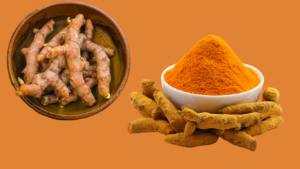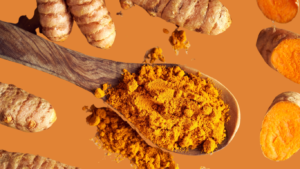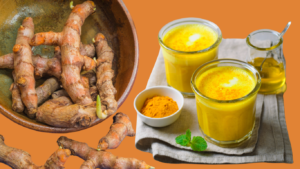Turmeric, known as the “golden spice,” has been a cornerstone of traditional medicine and cult practices for centuries. Its vivid color and myriad health benefits have made it a favorite ingredient across the globe.
But when it comes to using turmeric, many people wonder: should they opt for fresh turmeric root or its dried, powdered counterpart?
While both forms come from the same plant, they differ significantly in flavor, nutritional content, shelf life, and versatility.
This article delves deep into the distinctions between fresh and dried turmeric, helping you make informed decisions based on your needs.
1. The Origins of Turmeric

Turmeric (Curcuma longa) is a rhizome, much like ginger, and is native to South Asia. Traditionally used in Indian, Southeast Asian, and Middle Eastern cuisines, it is revered not only for its vibrant color but also for its medicinal properties.
Turmeric’s active compound, curcumin, is known for its anti-inflammatory, antioxidant, and immune-boosting properties.
Turmeric is typically harvested in its fresh form, resembling a smaller, orange-hued version of ginger. To create dried turmeric, the fresh rhizomes are boiled, dried, and ground into powder. This process alters its properties, resulting in notable differences between the two forms.
Related Read: The Different Types of Turmeric
2. Flavor Profile: Fresh vs. Dried Turmeric

Fresh Turmeric:
Fresh turmeric has a vibrant, earthy, and slightly citrusy flavor with a mild bitterness. Its taste is more subtle compared to dried turmeric, making it an excellent choice for recipes where you want to add a nuanced, fresh zing without overpowering other ingredients. When sliced or grated, fresh turmeric can elevate salads, teas, smoothies, and soups.
Dried Turmeric:
Dried turmeric has a more intense, concentrated flavor. The drying process amplifies its earthiness and bitterness while losing some of the fresh, citrusy undertones. It’s the preferred choice in dishes like curries, stews, and spice blends where a robust flavor profile is desirable. However, its strong taste means you need to use it sparingly to avoid overwhelming your dish.
Related Read: How to Use Turmeric in Your Daily Diet
3. Nutritional Content

The nutritional profile of turmeric changes between its fresh and dried forms due to processing.
Fresh Turmeric:
- Fresh turmeric retains more of its natural oils and volatile compounds, which contribute to its delicate aroma and some health benefits.
- It is rich in vitamin C, offering immune-boosting properties that are less pronounced in dried turmeric.
- The water content in fresh turmeric dilutes its curcumin concentration slightly compared to the dried form.
Dried Turmeric:
- Dried turmeric has a higher concentration of curcumin, making it more potent for medicinal uses.
- The drying process reduces the vitamin C content but enhances the availability of certain antioxidants.
- It is more calorie-dense than fresh turmeric due to the absence of water.
Conclusion: Both forms are nutritionally beneficial, but fresh turmeric may be more suitable for recipes emphasizing vitamin C, while dried turmeric is better for concentrated curcumin intake.
Related Read: Is Turmeric Effective for Enhancing Immunity?
4. Shelf Life and Storage

One of the most practical differences between fresh and dried turmeric is their shelf life and storage requirements.
Fresh Turmeric:
- Fresh turmeric has a short shelf life. It can last about 1-2 weeks in the refrigerator when stored in an airtight container or wrapped in a paper towel.
- For long-term storage, fresh turmeric can be frozen for up to six months.
Dried Turmeric:
- Dried turmeric is incredibly shelf-stable. When stored in an airtight container in a cool, dark place, it can retain its potency for up to 2-3 years.
- Its convenience and longevity make it a more practical option for those who use turmeric sporadically.
5. Culinary Uses

Fresh Turmeric:
Fresh turmeric is versatile in recipes where its vibrant color and mild flavor can shine. Some common uses include:
- Grating it into teas, golden milk, or smoothies for a natural energy boost.
- Slicing it into soups or stews to infuse them with subtle flavor.
- Using it in marinades for fish, poultry, or vegetables.
Dried Turmeric:
Dried turmeric is a staple in powdered form and is a key ingredient in many spice blends, such as curry powder and garam masala. It is typically used in:
- Curries, stews, and rice dishes for its robust flavor and golden hue.
- Baking, especially in recipes for turmeric-infused breads or cakes.
- Homemade skincare remedies, thanks to its antioxidant properties.
6. Health Benefits: Fresh vs. Dried

Both fresh and dried turmeric offer health benefits, but the concentration of compounds varies.
Fresh Turmeric:
- Offers more immediate anti-inflammatory effects due to its volatile oils.
- High in vitamin C, supporting immune health and skin vitality.
- Ideal for making fresh turmeric juice or turmeric paste for topical applications.
Dried Turmeric:
- Contains higher levels of curcumin, making it more effective for long-term anti-inflammatory and antioxidant benefits.
- Used widely in dietary supplements and herbal medicines.
- Easier to incorporate into daily diets due to its versatility and potency.
7. Aesthetic Appeal

Fresh turmeric stands out with its vibrant orange color and glossy skin. Its natural appearance makes it a popular choice for garnishes or raw preparations where presentation matters. Dried turmeric, on the other hand, is more subdued in appearance but delivers a more intense yellow when added to dishes.
8. Environmental Impact

Fresh Turmeric:
- Requires more energy and resources to transport and store due to its shorter shelf life and perishable nature.
- Often locally sourced, reducing its carbon footprint if purchased fresh in-season.
Dried Turmeric:
- Easier to transport in bulk and has a significantly lower spoilage rate.
- Widely available year-round, making it more accessible to global consumers.
9. Cost Considerations

Fresh turmeric is typically more expensive per pound compared to dried turmeric because of its perishability and limited availability in some regions. Dried turmeric, with its long shelf life and convenience, tends to be more budget-friendly, especially for bulk purchases.
10. Which Should You Choose?

The choice between fresh and dried turmeric ultimately depends on your needs:
- Choose Fresh Turmeric if:
- You’re looking for a subtle, fresh flavor for beverages, salads, or light dishes.
- You prefer minimally processed ingredients.
- You’re preparing recipes that call for turmeric’s natural oils.
- Choose Dried Turmeric if:
- You need a concentrated form of turmeric for robustly flavored dishes.
- You’re incorporating turmeric into a daily supplement routine for health benefits.
- Convenience and longevity are your priorities.
Conclusion
Both fresh and dried turmeric have their unique strengths and applications, making them invaluable in their own ways. While fresh turmeric shines in recipes that highlight its delicate, citrusy flavor and vibrant color, dried turmeric excels in providing concentrated flavor and health benefits with unmatched convenience.
Incorporating both forms into your diet allows you to enjoy the full spectrum of this golden spice’s versatility. Whether you’re sipping a soothing cup of fresh turmeric tea or stirring dried turmeric into a hearty curry, you can harness its incredible benefits to enrich both your culinary creations and overall well-being.

